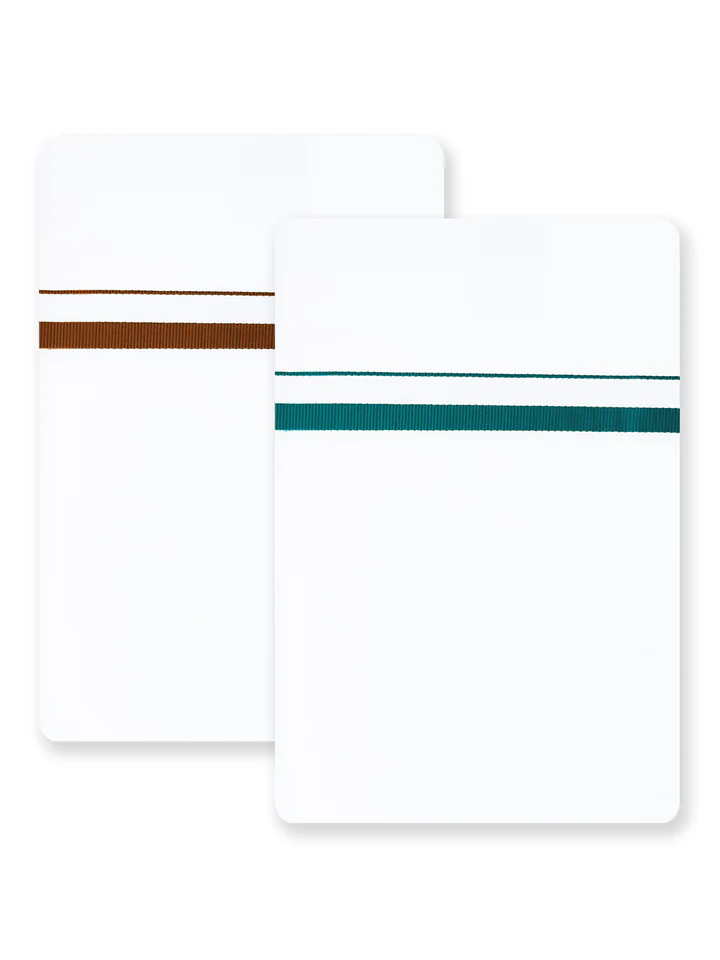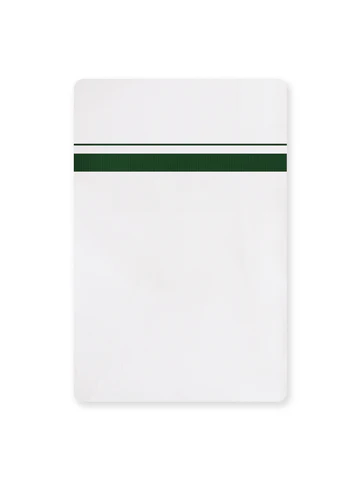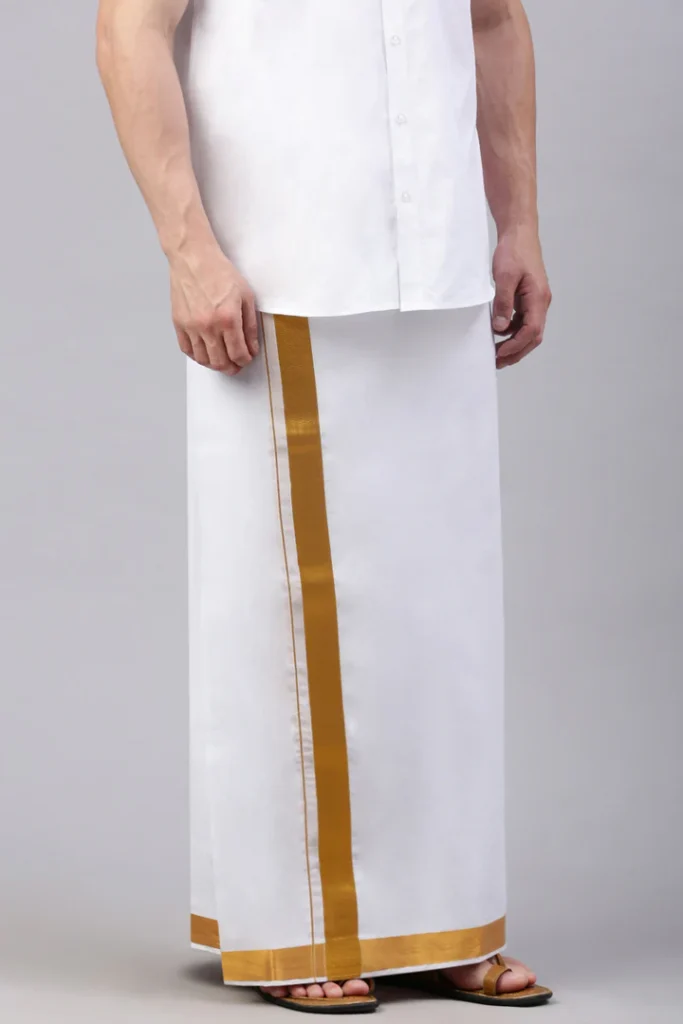Introduction
In the rich world of Indian clothing, few garments evoke as much respect and admiration as the big border dhoti. Whether worn in a rural village, at a city wedding, or in a place of worship, this timeless garment remains a mark of cultural pride and elegance.
From its crisp pleats to the striking woven borders, the big border dhoti stands out as a confident declaration of tradition. Even as modern fashion evolves, this style continues to be a favorite for special occasions, rituals, and festive gatherings.

What Makes a Big Border Dhoti Unique?
A big border dhoti is a long piece of unstitched fabric, usually around four to five meters in length. What sets it apart is its elaborate, wide border—often woven with shimmering zari in gold or silver threads.
The contrast between the plain field of the cloth and the bold border creates an unforgettable look. In many communities, the width and design of the border are associated with prestige and celebration.
Wearing a big border dhoti is about more than just style—it is about stepping into a heritage that values ceremony and visual splendor.
The Veshti: Southern Elegance
In South India, the veshti has become almost synonymous with cultural identity. From Tamil Nadu to Andhra Pradesh, this version of the dhoti is often seen during weddings and major religious events.
A veshti with a broad gold border symbolizes prosperity and honor. In Tamil weddings, the groom often wears an immaculate white or off-white veshti with a shimmering border, paired with a silk angavastram. This combination is considered the height of refinement and tradition.
When a veshti is folded and draped properly, it transforms the wearer’s presence—confident, composed, and dignified.

Pairing the Big Border Dhoti with Angavastram
For many, no ceremonial outfit feels complete without an angavastram. This is a matching or contrasting shoulder cloth that adds both elegance and symbolism.
During religious functions or weddings, draping an angavastram over the shoulder signifies respect and readiness for ritual. A big border dhoti with a coordinated angavastram is often gifted to elders or temple priests as a gesture of honor.
This pairing represents the perfect balance of simplicity and grandeur.
Occasions to Wear the Big Border Dhoti
The big border dhoti is reserved for moments that deserve special recognition. It is a garment that instantly sets the tone for celebration and reverence.
Common occasions where it shines:
- Wedding ceremonies, especially for grooms and close family members
- Temple festivals and annual rituals
- Vedic ceremonies such as thread ceremonies, yagnas, and homams
- Cultural programs and classical dance performances
In these settings, the wide shimmering border becomes a visual expression of joy, tradition, and respect.

Regional Styles and Craftsmanship
Different regions in India have their own distinctive approach to weaving the big border dhoti.
- In Tamil Nadu, the wide zari border in gold is iconic and often woven by skilled artisans in Kanchipuram or Salem.
- Kerala’s kasavu style uses a thick golden border against pure white cotton, worn during Onam and Vishu.
- Andhra Pradesh and Karnataka are known for traditional attire featuring bold contrasting borders in red, green, or maroon.
- In Bengal, ceremonial dhotis sometimes carry a broad red border with intricate motifs.
Each version highlights the artistry and cultural depth of India’s weaving traditions.
Choosing the Right Big Border Dhoti
When you shop for a big border dhoti, it helps to think about the occasion, climate, and your own comfort.
Things to keep in mind:
- Fabric: Pure cotton is best for temple wear and warm weather, while silk makes an impression at weddings.
- Border Design: Wider zari borders add grandeur, while simpler stripes feel more understated.
- Length: The garment should reach the ankle or calf, depending on regional custom.
- Ease of Use: Readymade options are available but may lose some of the traditional appeal of an unstitched dhoti.
Big Border Dhoti and Traditional Attire
While some see it as formal, the big border dhoti is an important part of traditional attire. It represents a moment to pause from modern routine and step into something meaningful.
When you wear it, you’re not only dressing up for the day—you are honoring a heritage that stretches back generations. The striking border acts as a reminder of your roots, your family stories, and the shared culture that unites communities across India.
Trending Big Border Styles
In recent years, trending big border styles have emerged as designers and younger generations revisit this classic garment.
Today’s versions often include:
- Contemporary geometric patterns woven into the border
- Subtle pastel fabrics paired with metallic borders
- Lightweight blends of cotton-silk for comfort and sheen
- Coordinated dhoti and angavastram sets packaged as wedding gifts
These styles prove that even the most time-honored garments can evolve while preserving their original spirit.
Caring for Your Big Border Dhoti
To keep the beauty of your dhoti intact, follow a few care tips:
- Gently hand-wash with mild detergent for cotton varieties.
- Dry-clean silk dhotis to protect the zari work.
- Store them folded neatly in a cotton cloth to prevent damage.
- Avoid direct sunlight to preserve the brightness of the border.
Proper care ensures the dhoti remains a cherished garment for years, sometimes even passed down across generations.
The Big Border Dhoti in Heritage Tourism
If you visit temple towns or heritage sites, you’ll often see men wearing the big border dhoti as a symbol of respect for sacred spaces. In places like Madurai, Kanchipuram, and Srirangam, wearing traditional attire is more than etiquette—it is an expression of cultural belonging.
Heritage tourism experiences frequently include lessons in draping the dhoti or shopping for handwoven pieces. Visitors find joy in learning how this simple garment carries so much meaning.
Inspiration from Mahatma Gandhi
Though Mahatma Gandhi is often associated with simple khadi cloth, he frequently spoke of clothing as a statement of identity and values. Choosing a big border dhoti can feel like reconnecting with those principles: simplicity, dignity, and pride in local craft.
In a way, wearing it becomes both a personal and cultural declaration.
Hot Weather Tips for Comfort
Because India has long hot seasons, staying comfortable in ceremonial attire is important. Here are a few hot weather tips:
- Choose lightweight cotton over heavy silk if you’ll be outdoors.
- Drape loosely to allow air circulation.
- Wear a thin cotton vest underneath for added comfort.
These simple steps make it easier to look elegant without feeling overheated.
Conclusion
The big border dhoti is more than fabric—it’s a symbol of India’s artistic legacy and a connection to your roots. From the festive shimmer of the border to the quiet dignity of its drape, this garment holds generations of stories.
Whether you’re attending a temple festival, a wedding, or a cultural program, wearing it is a way to honor tradition while embracing the present. In a world of fast-changing trends, the big border dhoti proves that some styles never fade. They evolve, adapt, and continue to inspire.
So the next time you unfold its wide border and wrap it around your waist, remember: you are stepping into a heritage that has shaped countless lives—and you are adding your own story to it.
